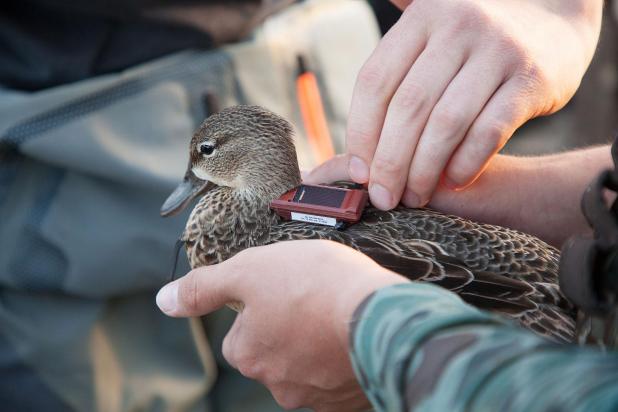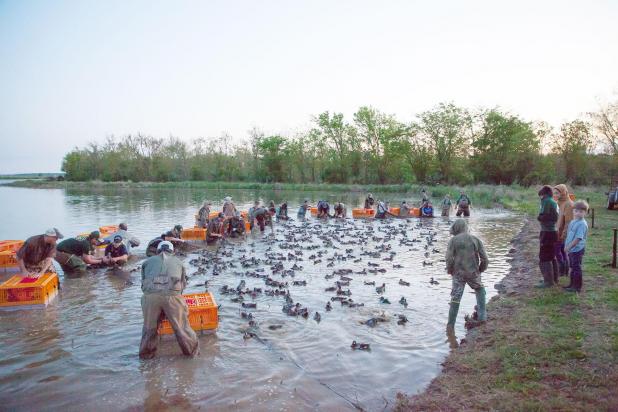

John Flores: Telemetry study examines blue-winged teal migration
In the twilight of a new day’s dawn this past Sunday, a large group of volunteers quietly gathered together in a wood-line along the edge of a large rice field pond several miles north of Krotz Springs. The only sounds heard were the droning calls of bull frogs trying to entice their potential mates and the soft low whispers of a few conversations going on among group members.
Suddenly, a “boom” similar to a large firework report filled the air and interrupted what was otherwise a tranquil morning.
The explosion was actually a rocket net launched by Louisiana Department of Wildlife and Fisheries’ North American Waterfowl Management Plan Coordinator, Paul Link, that settled over some 500 blue-winged teal and was the signal for volunteers to spring into action.
For the next 20 minutes the scene was a controlled chaos, as large orange holding crates were deployed into the water and filled by those enlisted to help as they meticulously cleared the 40-by-60-foot net of birds.
One by one the floating cages were gently lifted onto the rice field levee where systematically the teal were segregated into groups of males and females for banding purposes.
Among the group members was Brett Leach, a graduate student from the University of Missouri in Columbia, Missouri. Leach’s involvement in the banding effort Sunday happens to be part of his degree program as he works toward his Masters in Natural Resources with a wildlife emphasis.
While bands were being placed on teal, Leach was fitting 10 female birds with telemetry units as part of a study he is working on titled, “Quantifying Blue Winged Teal Migration and Habitat Selection Using GPS/GSM Transmitters.”
Though the United States and Canada partner each year in the most sophisticated large scale population study known to man called the Waterfowl Breeding Population and Habitat Survey and state agencies conduct Mid-winter Waterfowl Inventory aerial surveys, Leach says actually little is known about blue-winged teal winter distribution, harvest and habitat use, particularly south of the border.
There are few band recoveries from countries like Mexico, where commercial hunting and subsistence living often takes place. Reporting of bands is virtually nonexistent due in large part to language and education barriers.
Unknowns that biologists are hoping to learn more about by using telemetry units include quantifying Blue Winged Teal spring and fall migrations, particularly their migration speed, use of stopovers, and timing of arrival to their breeding grounds.
With technological advances, transmitters are continuously becoming smaller and more precise, according to Leach. The GPS/GSM transmitters currently being used on blue-winged teal weigh approximately 10 grams and are generally set to record a location once per hour.
Other information they record includes date, time, altitude, speed, temperature, and accelerometer (forces caused by vibration or change in motion) data. The accelerometer data is particularly important as it allows biologists the ability to know when teal start to incubate eggs.
Leach, a Wisconsin native, said, “With this technology we’re finally able to get enough locations where we can actually quantify to the day how long the migration is taking. And part of the project will also involve looking at nesting success.
“We want to learn more about the habitats these birds are using in the winter and during the spring migration,” Leach continued. “We want to find out what all that means to nesting — are they going to be more or less successful?”
The ability to utilize lightweight transmitters also helps with ongoing disease surveillance work being conducted by the University of Georgia/Southwest Cooperative Wildlife Disease Study Program, according to Link.
Blue-winged teal are long-distance migrants that regularly cross international boundaries on two continents. Besides the United States, their wintering habitats also include Mexico, Central and South America. As such, there is a potential for teal to be exposed to diseases like Influenza A Viruses (IAV).
For the past nine years, the UGA/SCWDS study has participated in Link’s spring banding efforts. Due to the COVID pandemic, the past two years (2020, 2021) technicians were unable to collect data from captured ducks.
Before transmitters, all biologists had to go on for disease surveillance was two data points. The point of capture and the point of recovery (harvest/reencounter). The problem with that is, when a blue-winged teal has been tested for diseases whether by swabbing of the trachea (throat) or cloaca (posterior opening), or by taking a blood sample and it turns up positive or having antibodies, there’s no way to know where the bird was infected.
With banded and telemetry marked birds, reasonable assumptions can be made where they can be tracked to exactly, where that disease possibly came from.
Link also meticulously maintains field banding sheets recording every piece of information from a morning capture that not only includes general things like weather conditions, numbers of captures, and recaptures, but also GoPro footage of the entire event.
He is optimistic that one day there will be Artificial Intelligence software, where data can be dumped into a program creating life history models.
This spring, close to 50 transmitters have already been deployed with 130 being the study’s eventual goal. However, it’s important to note advances in technology often come with a high price tag. GPS/GSM transmitters of the size, make and model used on blue-winged teal cost approximately $1,500 per unit. As such, studies like this rely heavily on charitable donations from various companies, education, individuals and other partners along the way to fund this important science.
Those interested in supporting efforts like this telemetry project can go to the Louisiana Wildlife & Fisheries Foundation web site at www.lawff.org/waterfowl-supporters.
Link said, “Lots of people think we’re out there just slinging bands, but that’s not the case. We’re trying to learn more about these things and, where banding is concerned, more is always better. We’ve built a huge recapture data base. For everyone that gets shot and reported, I’m recapturing another one. We normally don’t have that for a species as poorly monitored as a teal. Adding this technology will help us to fill some of the gaps on blue-winged teal populations for both conservation and human safety.”
